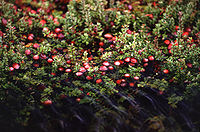
Photo from wikipedia
The fruits of Vaccinium oxycoccos L. are an important source of bioactive compounds with antibacterial, antifungal, and anti-inflammatory effects. Studies on the phytochemical analysis of cranberry fruit samples showed that… Click to show full abstract
The fruits of Vaccinium oxycoccos L. are an important source of bioactive compounds with antibacterial, antifungal, and anti-inflammatory effects. Studies on the phytochemical analysis of cranberry fruit samples showed that the qualitative and quantitative composition of biologically active compounds varied in cranberry fruit samples collected from different types of wetland sites: the total anthocyanin content was 698 ± 24–8352 ± 200 µg/g, the total flavonol content—518 ± 16–2811 ± 31 µg/g, the total content of triterpene compounds—4060 ± 122–6542 ± 157 µg/g, the content of chlorogenic acid—17 ± 0.4 µg/g to 1224 ± 41 µg/g, and the total content of proanthocyanidins—919 ± 19 µg EE/g to 3038 ± 137 µg EE/g. The percentage composition of anthocyanins in cranberry fruit varied between the different wetland sites: in some cranberry fruit samples, four anthocyanins (cyanidin-3-galactoside, cyanidin-3-arabinoside, peonidin-3-galactoside, and peonidin-3-arabinoside) were predominant, while in other samples, six anthocyanins (cyanidin-3-galactoside, cyanidin-3-arabinoside, peonidin-3-galactoside, peonidin-3-arabinoside, cyanidin-3-glucoside, and peonidin-3-glucoside) predominated. The results of these studies showed the differences in the composition of secondary metabolites in the studied cranberry samples and prove that the standardization of the qualitative and quantitative composition of cranberry fruit raw materials and the application of routine tests are necessary for the expansion of the use of botanical raw materials in the production of functional foods and phytopreparations.
Journal Title: Plants
Year Published: 2023
Link to full text (if available)
Share on Social Media: Sign Up to like & get
recommendations!